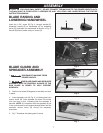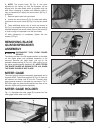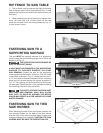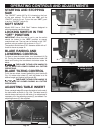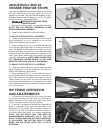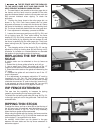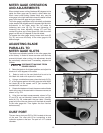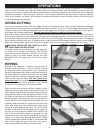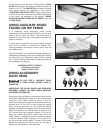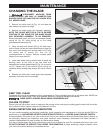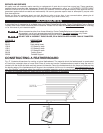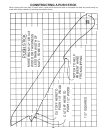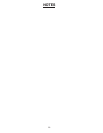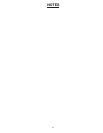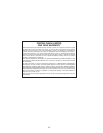
15
If the ripped work is less than 4 inches wide, a PUSH
STICK should always be used to complete the feed, as
shown in Fig. 35. The PUSH STICK can easily be made
from scrap material as explained in the section
“CONSTRUCTING PUSH STICK.” When ripping stock
2 inches or narrower, assemble an auxiliary wood facing
to the fence, as explained in the section “USING
AUXILIARY WOOD FACING ON RIP FENCE” and use
a PUSH STICK.
Fig. 35
USING AUXILIARY WOOD
FACING ON RIP FENCE
It is necessary when performing some special
operations to add wood facing (A) Fig. 36, to one or both
sides of the rip fence, as shown. The wood facing is
attached to the fence with wood screws through the
holes in the fence.
A wood facing should be used when ripping material
such as thin paneling to prevent the material from
catching between the bottom of the rip fence and the
saw table surface.
Further information on the safe and proper operation of
table saws is available in the Porter Cable/Delta “Getting
the Most Out of Your Table Saw” How-To-Book, Catalog
No. 11-400. Additional information on table saw safety is
also available by writing to:
NATIONAL SAFETY COUNCIL
1121 Spring Lake Drive
Itasca, IL 60143-3201
Fig. 36
A
USING ACCESSORY
DADO HEAD
DO NOT USE A “WOBBLE” DADO
BLADE, OR A DADO BLADE LARGER THAN 6"
DIAMETER.
IMPORTANT: THE BLADE GUARD AND SPREADER
ASSEMBLY CANNOT BE USED WHEN DADOING,
AND MUST BE REMOVED.
Dadoing is cutting a rabbet or wide groove into the work.
Most dado head sets are made up of two outside saws
and four or five inside cutters, as shown in Fig. 37.
Various combinations of saws and cutters are used to cut
grooves from 1/8" to 13/16" for use in shelving, making
joints, tenoning, grooving, etc. The cutters are heavily
swaged and must be arranged so that this heavy portion
falls in the gullets of the outside saws, as shown in Fig.
38. The saw and cutter overlap is shown in Fig. 39, (A)
being the outside saw, (B) an inside cutter, and (C) a
paper washer or washers which can be used as needed
to control the exact width of groove. A 1/4" groove is cut
by using the two outside saws. The teeth of the saws
should be positioned so that the raker on one saw is
beside the cutting teeth on the other saw.
Fig. 38
Fig. 37



